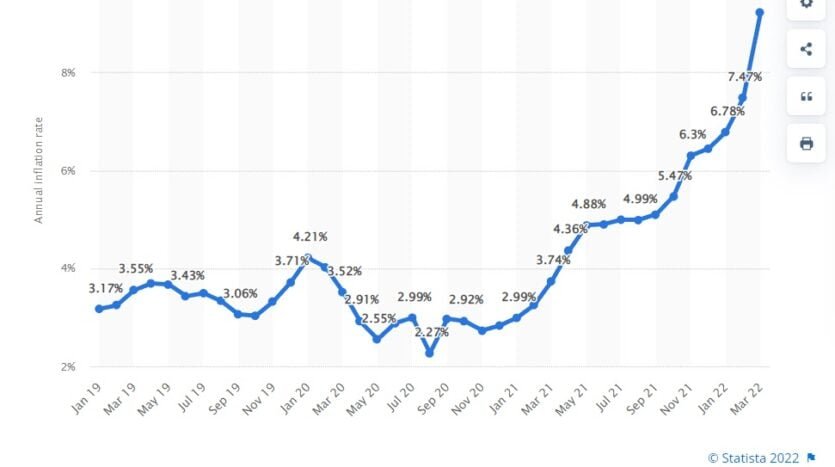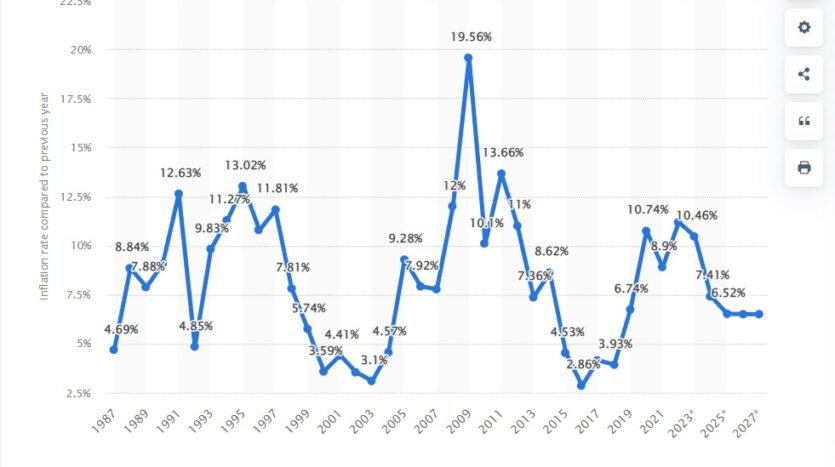Cash is Trash | PKR depreciation, inflation and why you need to invest right away
The past few months have been pretty volatile for the economy of Pakistan and the PKR has depreciated by 20% against the USD. The country struggles with hefty import costs, diminishing foreign exchange reserves, and political instability. I think most of the people were not ready for this blitzkrieg-style USD rampage and are left in shock and awe. Adding fuel to the fire the Government of Pakistan further levied new taxes on the real estate market, especially on the plots sector.
So what does it mean for an average Pakistani investor? and what do they need to do to minimize the impact of this inflation and PKR depreciation?
Rise of Global Inflation Post- Covid
The Governments cause inflation as inflation can only be caused by more money supply. This is not some genius idea by me. It won Milton Friedman a Nobel Prize in the 1970s.
The only way to bridge the economic cost post covid would be inflation because that way there would be no acute economic meltdown and instead there would be long-term inflation spreading the loss of wealth over time across the board. The cost of living has not gone up, you just got poorer as the buying power of your money went down. Inflation is the tool to adjust to the loss of wealth we have all suffered from the Covid hiatus.
Another way to look at this is the rise in demand is fueling this inflation. Driven by food and energy costs in the wake of the COVID-19 pandemic, inflation has been exacerbated by the Russian invasion of Ukraine.
The above picture shows you the global inflation index were it rose by 9.2% in March 22. In July the global inflation was recorded at7.6%.
Most economists agree that this inflation will persist through 2022 and most of 2023. The nonpartisan Congressional Budget Office released its forecast for next year and is predicting inflation will persist into next year before receding to normal levels by 2024.
What does higher inflation mean?
Inflation means you are going to pay higher for the same services or products as it rises. For the average person’s purchasing power this means your paycheck is not going as far as it once did unless your wages are increasing at the same pace, which has not been the case for most individuals. However, everyone’s true inflation rate is different because we all buy different products and services.
For investors who have a bunch of cash stashed or invested in areas such as Banks, Stocks, Equities etc which can hardly cope up with inflation means they risk losing their purchasing power in the future.
Let’s assume that someone has 10 M at the start of 2022 and let us see how his investment will turn out against 11% inflation as expected in 2022 and 2023 in Pakistan:
- Scenario 1 : Cash , you have lost 22% of your wealth.
- Scenario 2 : Bank, you have lost 2% of your wealth.
- Scenario 3 : Mutual funds, you have gained 6% in 2 years.
- Scenario 4 : Rental real estate, you have gained 18% in 2 years.
Let’s say you have PKR 100 Lacs in a savings account that pays a 10% interest rate. After a year, you will have 110 Lacs in your account. But if the rate of inflation is running at 11%, you would need PKR 111 Lacs to have the same buying power that you started with. So even with a 10% interest on your savings you are still effectively losing money.
You’ve gained PKR but lost buying power. Any time your savings don’t grow at the same rate as inflation, you will effectively lose money.
PKR depreciation fueled further inflation
Since March 2022, PKR has lost almost more than 20% against USD, this has fueled further inflation. A devaluation leads to a decline in the value of a currency making exports more competitive and imports more expensive.
Generally, a devaluation is likely to contribute to inflationary pressures because of higher import prices and rising demand for exports. However, the overall impact depends on the state of the economy and other factors affecting inflation.
For me, this means I have almost lost 20% of my buying power. I am now poorer than I was in March 2022 even if I have 10% more money than I had in March 2022.
Where to Invest?
Like always you have a few options, you can call this fate and do nothing while accepting you are poorer than you were in March 2022 or you can take action and make up for your lost money.
This is the time to take action if you don’t want to lose your buying power. The sky-high inflation rates demand that you invest them in areas that can effectively beat inflation over the years. Take a look at the inflation rate of Pakistan over the years and its future forecast.
Billionaire investor Ray Dalio continued to urge investors to stay away from cash amid high inflation and warned stocks look even worse. The founder and co-chief investor of Bridgewater Associates, the world’s largest hedge fund, has been saying for years that cash is trash. In an interview with CNBC at the Davos World Economic Forum, he doubled down.
“Of course, cash is still trash,” he said. “Do you know how fast you’re losing buying power?”
He added, “equities are trashier.” Instead of stocks or cash, “real-return assets” are the best investments, he explained.
So what are real return assets?
Real return is what is earned on an investment after accounting for taxes and inflation. Real returns are lower than nominal returns, which do not subtract taxes and inflation.
In easy words, you have to invest in assets that give you a higher return than inflation and taxes, so if inflation is 11% and taxes account for 1% an asset that would give you a 12% return can be considered a real return asset.
If you are not going to invest in a real return asset right now, you will end up poorer every passing day.
The best bet – real assets
Real assets are physical assets that have an intrinsic worth due to their substance and properties. Real assets include precious metals, commodities, real estate, land, equipment, and natural resources. They are appropriate for inclusion in most diversified portfolios because of their relatively low correlation with financial assets, such as stocks and bonds.
Real assets tend to be more stable than financial assets. Inflation, shifts in currency values, and other macroeconomic factors affect real assets less than financial assets. Real assets are particularly well-suited investments during inflationary times because of their tendency to outperform financial assets during such periods.
Returns from both real estate and infrastructure have a positive correlation to inflation, especially when it is combined with high economic growth. Real assets can capture inflation through greater income growth due to higher rent growth, occupancy, and increased demand for underlying goods such as electricity.
The best real asset in my opinion in Pakistan would be real estate but that’s a story for my next blog.
CALL US NOW
Captain (Retd) Shahnawaz Yaqub Bhatti
Investment Consultant and CEO at Imlaak
Mob : +92 333 1616160 ( Whatsapp)
Mob : +92 300 2048048 ( Whatsapp)






